Which Materials Are Best for Business Cards?

The concept of business cards was merely a handwritten note on a piece of paper used to advertise one’s skills. There was nothing fancy about it. But if you must get noticed in today’s fast-paced, highly competitive business world, you must leverage every opportunity to set your business apart from the crowd, and that includes having a card that is distinctively unique and leaves a long-lasting impression on the recipient.
One way to do that is to be intentional about the quality of the business card materials you use. So if you are trying to make up your mind on the business card material that best suits your company’s personality and brand positioning, you are in the right place.
This article will show you the card material options and what you should look out for when choosing materials for your card.
Why is it important?
As we said in my opening paragraph, business cards used to be purely for advertising one’s skills. But today, instead of just advertising people’s skills, they do much more, including being used for branding, networking, and promotions.
They are a great opportunity to make a fast and easy first impression on business prospects. It tells your brand story at a glance. So, if you consider your cards an important channel to make an impression on prospects, consider what material are business cards made out of and then choose what suits your brand.
For example, a premium business card paper says a lot about the strength of your company.
The basics of business card paper
Now that you have made up your mind that you want a card that leaves a wow effect on your prospects, you might be wondering “what is the best material for business cards?”. To answer this, let’s dive straight into the basics of paper types and finishes
Weight
An important consideration you must note when choosing a business card is weight. The weight of a card is measured in how many hundredths of an inch thick a single sheet is
In the world of printing, the thickness is described using points, and a point is the same as one-thousandth or .001 inches. By this logic, a 10pt paper is 0.01 inch in thickness. And the higher the number, the thicker the paper.
Even though there are diverse business card material types, the 16pt stock is generally adopted as the most widely accepted industry standard. This paper type is thicker and, of course, more durable.
Finish
Finishing is the icing on the cake because it brings an extra touch of finesse and elegance to the card. Aside from choosing the card thickness, you need to choose the finish for your card.
There are a variety of options to choose from. The most common finishes are matte and gloss. Matte finish is a flat finish that creates a more subtle tone and maintains a classic feel. It is also more resistant to fingerprints and smudges.
The gloss finish is shinier and brighter than the matte, creating a high-end look. It can also make colors appear more vibrant. Another popular finish is spot UV, which adds a glossy texture to certain areas of the card, creating a unique and eye-catching design.
For a more textured feel, you can choose embossed or debossed finishes. Embossed cards feature raised lettering and designs, while debossed cards have imprinted designs that are indented into the card. Finally, you can opt for metallic finishes, which give your card a luxurious touch and shimmer.
Making decisions based on impressions
In business, brand positioning is key, and your brand message must be seen across every available touch point. For example, if your company is positioned as a premium brand, you want to print a business card that reflects that. For this, you may step up to the 32-pt or 48-pt business.
This will not only allow you to make a strong and lasting first impression on your prospects, but it will also easily position your company ahead of the competition. The higher the thickness, the more durable, classy, and elegant the card. But of course, it attracts higher printing costs.
Yet, acquiring a mind-blowing business is more than just the paper thickness, having a quality finishing is equally an important factor. The spot UV and the metallic finish give your branch a more prestige impression.
Following your budget while making a decision
Like in almost every other thing, money is a crucial factor when choosing your preferred business card material. Your final decision should be premised on how much you have budgeted for printing the business cards.
Remember that the higher you go on the paper thickness ladder, the more it will cost you. Finishes also vary in price, and you must consider what best fits your style and budget.
Printing business cards: where and how to do it
If you have read to this point, you may want to know where to get a business card printing service provider that delivers on these qualities. With a simple Google search, you will find loads of companies that are into business cards printing online.
However, if you want a good bang for your buck, 4OVER4.COM is the way to go. They do not compromise on quality while giving you the best price in the market.
Concluding remarks
Your decision on business card material types comes down to two things, what do you want the most from it, and how does it suit your business’s best interest? If you can effectively connect these dots, you are on your way to getting a business card that can entice your prospects and create opportunities for your company to grow.











Leave a Reply